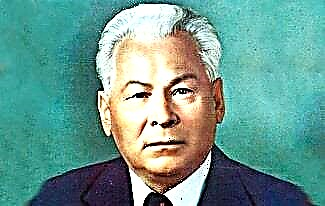The presence of air is one of the key properties of the Earth, thanks to which life exists on it. The meaning of air for living things is very diverse. With the help of air, living organisms move, feed, store nutrients, and exchange sound information. Even if you take the breath out of the brackets, it turns out that air is critical for all living things. This was already understood in ancient times, when the air was considered one of the four main elements.
1. The ancient Greek philosopher Anaximenes considered air to be the basis of everything that exists in nature. It all starts with air and ends with air. The substances and objects around us, according to Anaximenes, are formed either when the air is thickened or when the air is rarefied.

2. German scientist and burgomaster of Magdeburg Otto von Guericke was the first to demonstrate the strength of atmospheric pressure. When he pumped air out of a ball made of metal hemispheres, it turned out that it was very difficult to separate the unbonded hemispheres. This could not be done even by the combined efforts of 16 and even 24 horses. Later calculations showed that horses can deliver the short-term power needed to overcome atmospheric pressure, but their efforts are not well synchronized. In 2012, 12 specially trained heavy trucks still managed to separate the Magdeburg hemispheres.

3. Any sound is transmitted through the air. The ear picks up vibrations in the air of different frequencies, and we hear voices, music, traffic noise or birdsong. The vacuum is accordingly silent. According to one literary hero, in space, we will not hear a supernova explosion, even if it happens behind our back.
4. The first processes of combustion and oxidation as a combination of a substance with a part of the atmospheric air (oxygen) were described at the end of the 18th century by the genius Frenchman Antoine Lavoisier. Oxygen was known before him, everyone saw combustion and oxidation, but only Lavoisier could understand the essence of the process. He later proved that atmospheric air is not a special substance, but a mixture of different gases. Grateful compatriots did not appreciate the achievements of the great scientist (Lavoisier, in principle, can be considered the father of modern chemistry) and sent him to the guillotine for participating in the tax farms.

5. Atmospheric air is not only a mixture of gases. It also contains water, particulate matter and even many microorganisms. Selling jars labeled “City Air NN” is, of course, like a hoax, but in practice the air in different places really differs greatly in its composition.
6. Air is very light - a cubic meter weighs a little more than a kilogram. On the other hand, in an empty room measuring 6 X 4 and 3 meters high, there is about 90 kilograms of air.
7. Every modern person is familiar with polluted air firsthand. But the air, which contains a lot of solid particles, is dangerous not only for the respiratory tract and human health. In 1815, there was an eruption of the Tambora volcano, located on one of the Indonesian islands. The smallest ash particles were thrown in huge quantities (estimated at 150 cubic kilometers) into the upper atmosphere. Ashes enveloped the entire Earth, blocking out the sun's rays. In the summer of 1816, it was unusually cold throughout the northern hemisphere. It was snowing in the USA and Canada. In Switzerland, snowfalls continued throughout the summer. In Germany, heavy rains caused rivers to overflow their banks. There could be no question of any agricultural products, and imported grain became 10 times more expensive. 1816 is called “The Year Without Summer”. There were too many solid particles in the air.
8. The air is “intoxicating” both at great depths and at high altitudes. The reasons for this effect are different. At depth, more nitrogen begins to enter the blood, and at altitude, less oxygen in the air.
9. The existing concentration of oxygen in the air is optimal for humans. Even a small decrease in the proportion of oxygen negatively affects the condition and performance of a person. But the increased oxygen content does not bring anything good. At first, American astronauts breathed pure oxygen in the ships, but at a very low (about three times the normal) pressure. But staying in such an atmosphere requires a long preparation, and, as the fate of Apollo 1 and its crew showed, pure oxygen is not a safe business.
10. In weather forecasts, when talking about air humidity, the definition of “relative” is often overlooked. Therefore, sometimes questions arise like: "If the air humidity is 95%, then do we breathe practically the same water?" In fact, these percentages indicate the ratio of the amount of water vapor in the air at a given moment to the maximum possible amount. That is, if we are talking about 80% humidity at a temperature of +20 degrees, we mean that a cubic meter of air contains 80% of steam from the maximum 17.3 grams - 13.84 grams.
11. The maximum speed of air movement - 408 km / h - was recorded on the Australian island of Barrow in 1996. A large cyclone was passing there at that time. And over the Commonwealth Sea adjacent to Antarctica, the constant wind speed is 320 km / h. At the same time, in complete calm, air molecules move at a speed of about 1.5 km / h.
12. “Money down the drain” does not mean throwing bills around. According to one of the hypotheses, the expression came from a conspiracy "into the wind", with the help of which damage was imposed. That is, money in this case was paid for imposing a conspiracy. Also the expression could come from the wind tax. The enterprising feudal lords levied it on the owners of windmills. The air is moving over the landlord's lands!
13. For 22,000 breaths per day, we consume about 20 kilograms of air, most of which we exhale back, assimilating almost only oxygen. Most animals do the same. Plants, on the other hand, absorb carbon dioxide and release oxygen. A fifth of the world's oxygen is produced by the jungle in the Amazon Basin.
14. In industrialized countries, one tenth of the electricity generated goes to the production of compressed air. It is more expensive to store energy in this way than to take it from traditional fuels or water, but sometimes you cannot do without compressed air energy. For example, when using a jackhammer in a mine.

15. If all the air on Earth is collected in a ball at normal pressure, the diameter of the ball will be about 2,000 kilometers.









